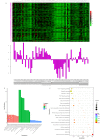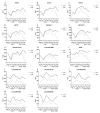Identification of the Key Genes Associated with Different Hair Types in the Inner Mongolia Cashmere Goat
- PMID: 35681921
- PMCID: PMC9179306
- DOI: 10.3390/ani12111456
Identification of the Key Genes Associated with Different Hair Types in the Inner Mongolia Cashmere Goat
Abstract
The Inner Mongolia cashmere goat is an excellent local breed in China. According to the characteristics of wool quilts, the Inner Mongolia cashmere goat can be divided into three types: a long-hair type (hair length of >22 cm), a short-hair type (hair length of ≤13 cm), and an intermediate type (hair length of >13 cm and ≤22 cm). It is found that hair length has a certain reference value for the indirect selection of other important economic traits of cashmere. In order to explore the molecular mechanisms and related regulatory genes of the different hair types, a weighted gene coexpression network analysis (WGCNA) was carried out on the gene expression data and phenotypic data of 12-month-old Inner Mongolia cashmere goats with a long-hair type (LHG) and a short-hair type (SHG) to explore the coexpression modules related to different coat types and nine candidate genes, and detect the relative expression of key candidate genes. The results showed that the WGCNA divided these genes into 19 coexpression modules and found that there was a strong correlation between one module and different hair types. The expression trends of this module’s genes were different in the two hair types, with high expression in the LHG and low expression in the SHG. GO functions are mainly concentrated in cellular components, including intermediate filaments (GO:0005882), intermediate filament cytoskeletons (GO:0045111), and cytoskeletal parts (GO:0044430). The KEGG pathway is mainly enriched in arginine as well as proline metabolism (chx00330) and the MAPK signaling pathway (chx04010). The candidate genes of the different hair types, including the KRT39, KRT74, LOC100861184, LOC102177231, LOC102178767, LOC102179881, LOC106503203, LOC108638293, and LOC108638298 genes, were screened. Through qRT-PCR, it was found that there were significant differences in these candidate genes between the two hair types, and most of them had a significant positive correlation with hair length. It was preliminarily inferred that these candidate genes could regulate the different hair types of cashmere goats and provide molecular markers for hair growth.
Keywords: Inner Mongolia cashmere goats; KRT; WGCNA; different hair types; hair growth.
Conflict of interest statement
The authors declare no conflict of interest.
Figures







References
-
- Dubeuf J. Situation, changes and future of goat industry around the world. Small Rumin. Res. 2003;51:165–173. doi: 10.1016/j.smallrumres.2003.08.007. - DOI
Grants and funding
- 31860637/National Natural Science Foundation of China
- 2021ZD0012/Science and Technology Major Project of Inner Mongolia Autonomous Region
- CARS-39/China Agriculture Research System of MOF and MARA
- 2020ZY0007/Central Government Guides Local Science and Technology Development Fund Projects
- BZCG202111/Special Funding Project for the Iconic Achievements of the College of Animal Science, Inner Mongolia Agricultural University
LinkOut - more resources
Full Text Sources
Research Materials

